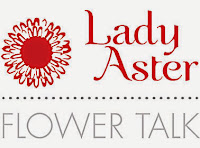If you live in the cool Northwest region of the United States, chances are you have spotted one of summertime's most beloved shrubs in your town--giant orbs of blue, pink, white, and lavender stretching skyward from big, leafy branches. Oh, Hydrangea!
 |
| Close-up of Hydrangea's florets |
The genus "Hydrangea" is represented by over 11 species of varying bloom shapes, but the cultivar most often used in cut flower arrangements are the globose heads of
H. macrophylla (affectionately referred to as "mopheads"). This highly decorative, bulbous form was born in the coastal areas of Honshu, Japan, developed extensively in Europe, and was introduced to the United States well over a century ago.
At first glance, the garden varieties around the northwest may appear similar to what we grow here on the farm, except for a few key differences. This is because over the last few years we have been planting more and more hybridized varieties. Why? Our trusty plant breeders have been working to produce varieties of Hydrangea which possess the longest vase life, with the sturdiest stems and the most vibrant (and giant) blooms. And now their breeding success has become our viewing pleasure!
 |
| Many Hydrangea varieties can produce pink, lavender, and deep blue blooms depending on the soil's pH. |
These immense and billowy flower heads are made up of multiple florets which boast long-lasting color. And the varying colors of Hydrangea are fascinating! Yes, different cultivars will give us clear blues, vivid pinks, pure whites, shades of frosty lavender and coral—but their color and intensity
can vary depending on the acidity of the soil or water that is used. Aluminum sulfate will reduce the soil's pH, causing a hydrangea to produce blue and lavender blooms, while a higher soil pH will give us vibrant pinks. It is even possible for some cultivars to produce different color blooms on one plant! (Further on in the growing season, hydrangeas' coloration gets even more interesting, giving us the marbled tones of
Antiqued Hydrangeas.)Soil pH aside, the most important element to growing long-stemmed, giant blooms is temperature and light.
H. macrophylla originated in the temperate maritime climate of coastal Japan, which bodes well for us flower farmers in Coastal California.
Hydrangeas love a coastal setting, where cool breezes dissipate the heat. Heat and too much sunlight can be a problem for these blooms, as they are sensitive to drooping from heat stress.
We grow ours in open shade-houses which allows for the circulation of cool sea breezes, while giving the plants just enough (but not too much) sunshine. This one-two combination encourages stem length and complete coloring of the florets. In winter, we keep the dormant plants uncovered, where the abundant Humboldt rainfall nourishes the shrubs for production the following spring.
 |
| Young hydrangeas stretching skyward in our shade-house. |
Thanks to our forward-thinking growers here and our ground-breaking breeders across the pond, Sun Valley is on the forefront of America's Cut Flower Hydrangea Market. Our new hybridized varieties look stunning in wedding bouquets, in large, upscale arrangements, as single stems, or even gathered together in a rustic display of color, as in the photo below. They're fun and versatile blooms, giving you the creative freedom to build what you like. Take ours, and make them yours!






































